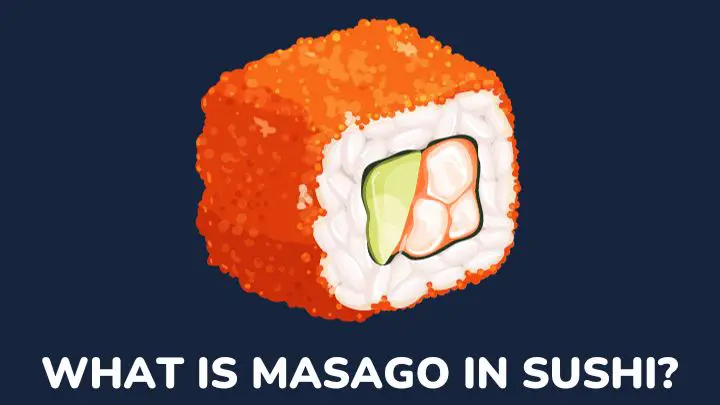Masago is a popular inclusion in Asian cuisine. It is valued for its vibrant orange hue, unique taste, texture, and nutritional benefits. Masago is one of the lesser-known sushi ingredients. It is not very popular, and it is not so rare either.
This semi-crunchy ingredient has gained a lot of popularity among sushi chefs and lovers of Japanese food. However, not so much is known about masago except that it is fish roe and served raw.
If you are looking to learn more about this awesome Japanese ingredient, you should continue scrolling. Learn about masago in sushi – what it is, its taste profile, how to use it, health benefits, and potential side effects.
What is masago in sushi?
Masago is the Japanese word for smelt roe (eggs). Smelt roe is prepared from the eggs of the capelin fish, which is found in the Arctic, Atlantic, and Pacific oceans.
Capelin fish is a small forage fish that serves as a food source for other fishes like whales, seals, seabirds, and codfish.
Capelin is a sleek, slender fish with an olive-green back and silver belly, with much resemblance to sardines. They lay their eggs on the gravel of beaches, unlike other smelts that lay theirs in freshwater.
This fish is bred more commonly for its eggs. The female capelin begins producing eggs from the age of 2-4; they carry 6,000 to 30,000 eggs. The eggs are harvested for products like masago just before the fish begins to spawn.
Furthermore, capelin roe is pale yellow and is sometimes dyed to have a vibrant orange, red, or yellow to enhance the appearance of sushi rolls.
What does masago taste like?
Masago has a rich flavor. It is savory and briny like most seafood. The rich flavor comes from the different curing ingredients like salt, MSG, high-corn fructose syrup, and soy sauce. Its sand-like texture adds a bit of a crunch to any dish.
Types of masago
The different types of masago are all from the roe of capelin, but they differ in color due to the different food coloring used.
Orange masago
This is the most common type of masago. It has a mild flavor, with a subtle sweet and umami-like taste. The orange hue comes from FD&C yellow #6 food dye. It includes curing ingredients like MSG, soy sauce, corn syrup, and salt.
Black masago
Black masago gets its color from FD&C Yellow #5, Blue #1, and Red #40. It is not as flavorful as orange masago, but it is equally nutritious. It uses the same curing ingredients as orange masago.
Red masago
Red masago shares a lot of similarities with orange masago. But its color comes from FD&C Red #40 dye instead of Yellow #6. It includes the same ingredients as orange masago and tastes the same.
Wasabi masago
Wasabi masago stands out from the others in terms of flavor. It is flavored with horseradish or wasabi and gets its color from yellow and blue food dyes. The curing ingredients in this capelin roe are the same as with others.
Is masago healthy?
Masago is a healthy addition to sushi rolls and any other meal you add it to. It is a low-calorie roe that is high in other nutrients. Below are some of the nutritional and health benefits you can get from eating masago:
A good dose of omega-3
Masago is high in omega-3 fatty acids. These fatty acids are good for heart health, eye health, cognitive functions, weight management, and reducing inflammation. They also help the body produce hormones that regulate blood clotting.
Masago is a complete protein
Not many people know this, but this fish roe contains all nine essential amino acids your body needs.
One ounce of masago contains the same amount of protein as one large chicken egg. As a rich protein source, it supports appetite control and weight management.
It is a natural source of vitamin D
Besides vitamin D-fortified milk, incorporating masago into your diet can help you meet up your vitamin D RDA. This fish roe supports calcium absorption for proper bone and muscle growth, repair, and function.
Vitamin D is an essential macronutrient that the body needs to support its resistance to insomnia, depression, osteoporosis in children, and fatigue.
Low mercury content
Most people are afraid of consuming mercury in seafood. This is not the case with masago. It is a low-mercury seafood option like salmon and tobiko. It is safe for everyone, including pregnant women if eaten in moderation.
How to get the best masago
Masago is available in online stores, in Japanese restaurants and markets, Asian supermarkets, and high-end seafood markets. The fastest and cheapest place to buy masago is from online stores.
The downside to online stores, however, is that due to the long distance they are shipped from, the eggs may have gone bad before they get to you. Physical markets and stores are more reliable for freshness and quality.
How to use masago in sushi
As fillings for sushi rolls
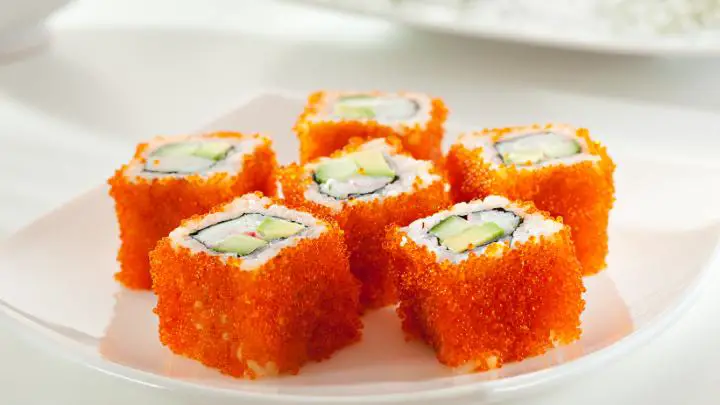
Masago can be a part of the fillings in your maki rolls. It contributes a crunchiness, extra fishy flavor, and taste to it without overpowering the natural sushi flavors.
Make a neat sushi roll by placing the main fillings – cucumber strips, avocado slices, and raw fish in a row.
Then, add a line of masago just beside the main fillings and roll. You can use just masago or mix it with spicy mayo for subtle hints of spiciness.
For nigiri and sashimi
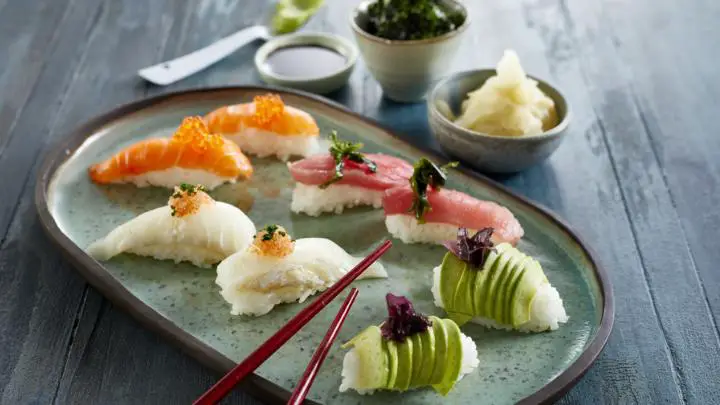
Masago is not for sushi rolls alone but can also be used in other sushi varieties such as sashimi and nigiri.
Nigiri and sashimi are other sushi varieties that do not come as rolls. Nigiri is served in bowls and sashimi in cups. Topping these dishes with masago increases its appeal and adds texture and an extra fishy flavor.
As toppings or garnishes
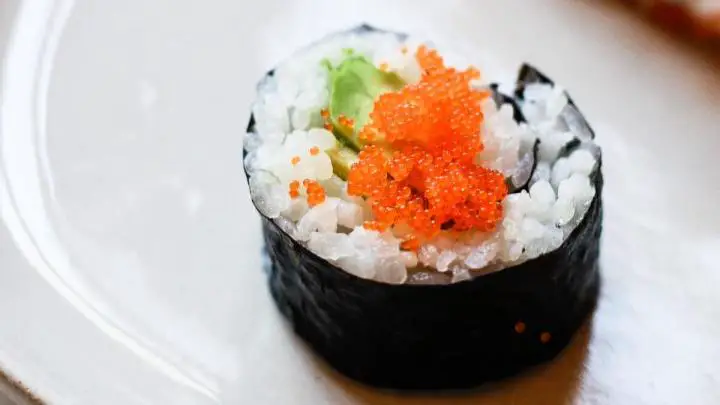
You can also use masago to add an aesthetic appeal to your sushi rolls. The crunch of the roe also complements the soft texture of the rice.
The rice is sticky and helps the roe to stick. You can add masago before or after the nori, depending on your preference.
Can you use masago in other dishes?
Yes, you can. Here’s a list of other Asian-inspired meals you can make with masago:
Creamy masago udon
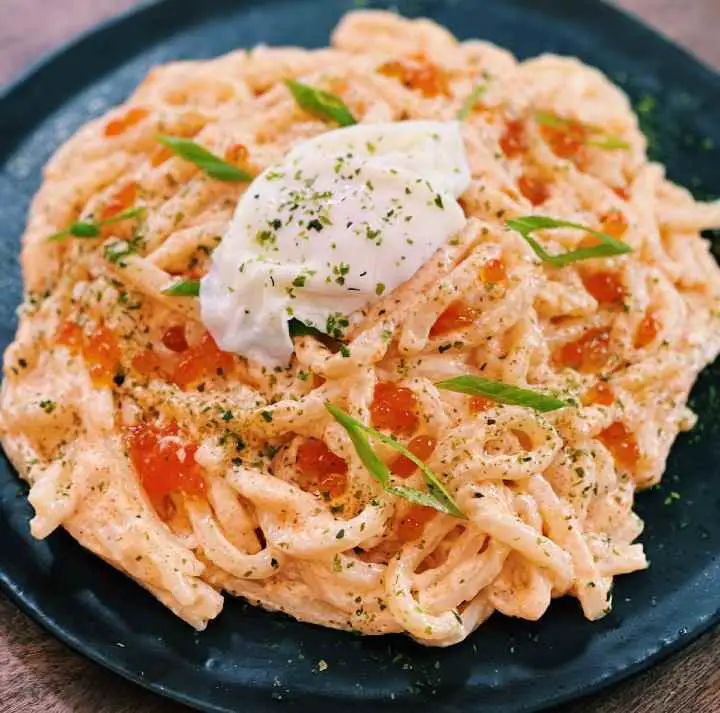
This meal is the perfect choice for a dinner date or a solo late-night meal. The creamy sauce is made with cream, butter, flour, garlic powder, Japanese mayonnaise, and a dash of dashi powder for an umami flavor. Add masago for extra texture and toss with udon.
Baked salmon with mayo and masago
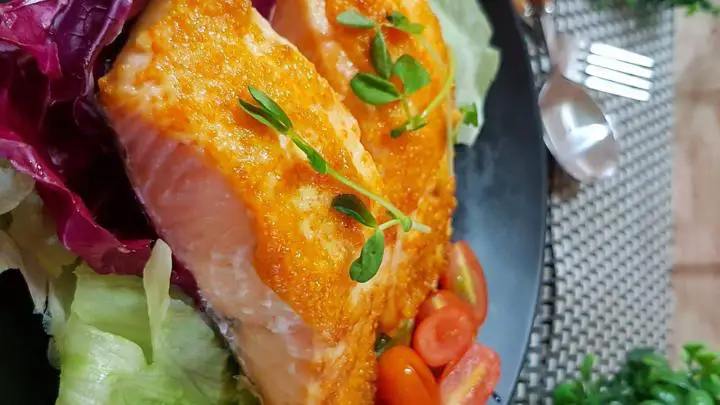
The salmon is seasoned with salt, pepper, and lemon juice. The fish is covered with mayo masago sauce, a combination of mayonnaise, masago, chopped green onions, chopped parsley, salt, and sriracha sauce before baking.
Masago pasta with poached eggs

Masago pasta is a bowl of soft, creamy pasta with a delicious fishy taste. You can use fettuccine or spaghetti pasta for your recipe.
Masago sauce
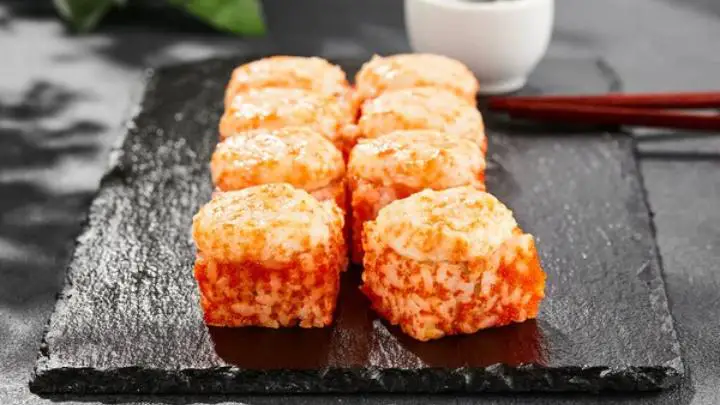
Masago sauce is one of the easiest masago recipes to try. It is a creamy blend of Japanese mayo, sriracha sauce, lime juice, and masago. Masago sauce pairs well with sushi, shrimp, or any other seafood.
You can also add masago to other dips to give them a crunchiness. Add masago to poke bowls with sushi rolls or create a bowl of appetizer with masago, cheese, and fruits.
Are there side effects of eating masago?
Yes, there are. Side effects of eating masago are:
There is a risk of an allergic reaction
Capelin roe contains vitellogenin, a type of egg yolk protein that causes allergic reactions in some people. Also, masago is not safe for people with shellfish or seafood allergies.
These allergic reactions have symptoms like rashes, difficulty in breathing due to narrowing of airways, and high blood pressure.
High sodium content
Fish roe is naturally high in sodium, and masago is not an exception. Moreover, ingredients like salt, MSG, and soy sauce increase its sodium content.
While it is good for heart health, it is unhealthy for people with heart problems or those at risk of developing them. In addition, too much sodium could lead to bone deterioration, stomach cancer, and kidney disease.
Effect on the ecosystem
Capelin is a forage fish, and their roe is food to humans. There is a risk that they may become endangered in the coming years because the pregnant females are harvested for masago.
May also include unhealthy ingredients
By itself, masago does not have too severe risks but in delicacies like sushi rolls, it is usually combined with other ingredients which could be unhealthy.
Sushi is raw food and contains refined carbohydrates. Eating raw fish increases the risk of foodborne illnesses and parasitic infections.
FAQs
Is masago ikura?
Masago is ikura. Masago is capelin roe, whereas ikura is salmon roe. Salmon are bigger than capelin fish, so they produce bigger eggs. Unlike masago, ikura is not crunchy because of its size. Instead, they burst in the mouth.
What is the difference between masago and tobiko?
Masago looks a lot like tobiko, especially red tobiko. Like masago, tobiko is available in different colors like green, black, yellow, and gold. Tobiko is flying fish roe, while masago is the roe of the capelin fish.
Also, tobiko is larger than masago and has a crunchier texture. Masago has a finer and softer texture, which is equally suitable for delicacies like sushi rolls.
Why is masago called caviar?
Some people call masago caviar because they are both used as a garnish in different recipes. However, they are not the same type of garnish. Masago is the roe of capelin, whereas caviar comes from the roe of any of the wild sturgeon fish.
Is masago sustainable?
Masago serves as food to many. The capelin fish is food for whales, seals, seabirds, etc, and the roe from the females are eaten by humans. Capelin fish is not yet an endangered species, but it looks like it soon will be since the females are majorly targeted.
There are uncertainties around the future of this economically important fish. Therefore, sustainable fishing practices are encouraged to reduce its impact on oceans and the ecosystem.
Conclusion
Masago is a fantastic addition to meals. This is no wonder because the Japanese believe that food must appeal to your senses to embrace the deliciousness of the meal. It is not only physically appealing but also delicious and highly nutritious.
Masago is fast becoming very popular across many cuisines. While you enjoy masago in sushi and other delicacies, remember to eat it in moderation.
Get better at making sushi with this step-by-step guide on how to cut salmon for sushi rolls.
Finally, did you know the Japanese eat whales? If you didn’t, here’s something juicy you should know about whale meat.
Thanks for reading.
